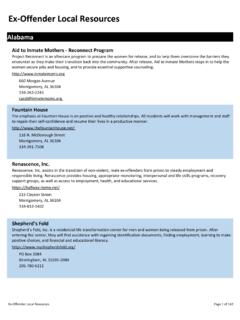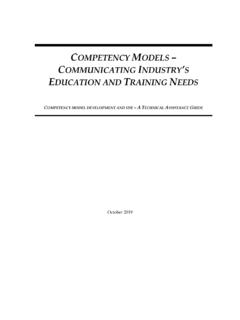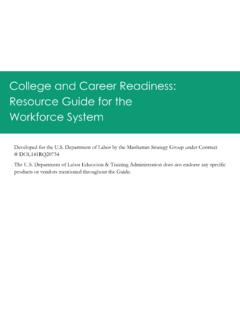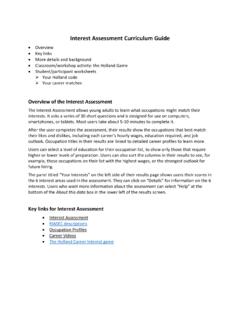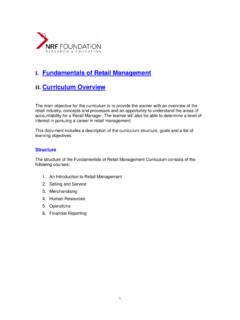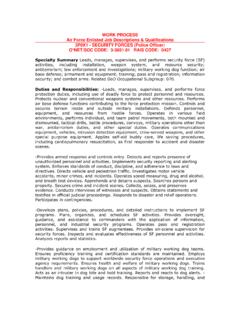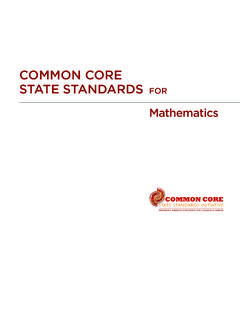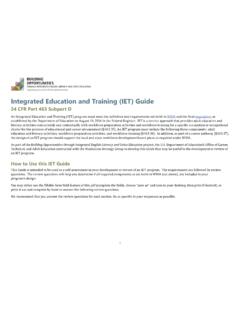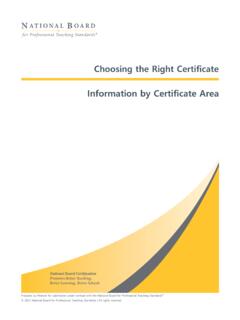Transcription of A Guide for Developing Competency Models
1 A Guide FOR Developing Competency Models ----- GUIDELINES FOR INCLUSION OF CUSTOM-DEVELOPED Models ON THE Competency MODEL CLEARINGHOUSE October 2015 Contents Purpose of this Guide .. 2 Benefits of Competency Model development .. 3 Guidelines for Model Inclusion on the Competency Model Clearinghouse .. 3 Guidance for Model development .. 3 Model Scope and Focus .. 3 The Model s development .. 4 The Model s Competency Descriptions .. 4 Model Sections .. 4 The Model s Validation .. 4 Process for Initiating Collaboration on a Competency .
2 5 Attribution and Citation of CMC Content .. 5 Style Guide .. 6 Model Structure .. 6 Scope of Foundational Tiers (Tiers 1, 2, and 3) .. 6 Scope of Industry Tiers (Tiers 4 and 5) .. 7 Structure of Competency Blocks .. 8 Grammar and Syntax: .. 8 Character Limits: .. 8 Numbering .. 8 Model Tiers - Overview .. 10 Industry Overview .. 11 Methodology .. 11 Resources Reviewed .. 11 US DOL Competency Model Submission Requirements .. 11 US DOL Guide for Developing Competency Models [2] The Energy Competency Model was one of the first things we developed when CEWD was formed back in 2006.
3 We felt it was critical to understand the skills and competencies that were required by the industry so that we would have a firm foundation for Developing our Get Into Energy Career Pathways. We have made some tweaks along the way, but the Competency model still stands as the basis for curriculum and credentials in our industry. Ann Randazzo Executive Director Center for Energy Workforce development Purpose of this Guide The Department of Labor, Employment and Training Administration (ETA) convenes industry partners and representatives of the workforce system, education, and labor, and related subject matter experts from relevant associations to develop Models that lay out the full array of cross-cutting competencies in an industry or sector from foundational to industry-wide, to technical competencies within a specific sub-sector.
4 These Models are used for a variety of purposes, discussed below, but the primary benefit is to widely publicize industry skill needs to inform efforts to develop a skilled and prepared workforce. These industry Competency Models are made readily available within an online portal--the Competency Model Clearinghouse (CMC). The Competency Models help identify the knowledge, skills, and abilities needed by a globally competitive workforce, and the Employment and Training Administration (ETA) encourages organizations to customize and use the Models found on the CMC and provides worksheets and tools on the site to assist in that effort.
5 ETA also can provide technical assistance and support to organizations that would like to develop their own industry-based Models , and encourages them to use the format and structure of the CMC Models . By doing so, model developers help ensure a level of consistency and quality across Models . This Guide is designed for organizations that would like to develop industry-based Competency Models for inclusion on the CMC. The Guide outlines: Benefits of Competency Model development : Industry Competency Models have many benefits for employers, workers, labor representatives, students, educators, and workforce development professionals.
6 This section describes these benefits. Guidelines for Model Inclusion: These are the requirements for the development process for the model and for the model itself in order for it to be considered for inclusion on the CMC. CMC Style Guide : This section provides the requirements for the style and format of the Competency model. US DOL Guide for Developing Competency Models [3] Model Submission: This section of the Guide describes the submission process and the documents to be included as part of the submission for placement of a model on the CMC.
7 Benefits of Competency Model development The industry Competency Models on the Competency Model Clearinghouse are developed and maintained in partnership with industry leaders to promote an understanding of the skill sets and competencies that are essential to educate and train a globally competitive workforce. They represent dynamic Models of the foundation and technical competencies that are necessary in economically vital industries and sectors of the American economy. They promote an understanding of the skill sets and competencies that are essential to educate and train a globally competitive workforce.
8 The Models serve as a resource to inform discussions among industry leaders, educators, economic developers, and public workforce investment professionals as they collaborate to: Identify specific employer skill needs Define career pathways and stackable credentials Develop Competency -based curricula and training Models Develop industry-defined performance indicators and certifications Develop resources for career exploration and guidance. Guidelines for Model Inclusion on the Competency Model Clearinghouse Guidance for development and inclusion of Models on the CMC is provided below and covers the model rationale, scope, and characteristics, as well as the steps in the development process.
9 Technical assistance in model development is available by contacting the CMC staff at Guidance for Model development Model Scope and Focus The scope of the model is national and cross-cutting, representing either an entire industry or major cluster of occupations in the The industry model should be designed to support entry and access to employment for occupations that cover a span of educational requirements and US DOL Guide for Developing Competency Models [4] industry-recognized credentials that include the sub-Baccalaureate level as well as any higher levels.
10 The projected demand for jobs in the industry should be either trending upward or steadily high. The industry should provide a pathway of occupations that lead to wages that are family-sustaining. The Model s development If it is an update to an existing model, the update is based on the model for that industry/field currently on the CMC. If it is a new model, the model development uses as a template and resource either the CMC Building Blocks model (first three foundational tiers) or a CMC industry model related to the new industry model under development The development of the model reflects a review of the current literature related to competencies, certifications, assessments, curricula and other sources of information on industry Competency requirements.

